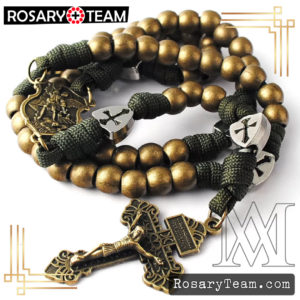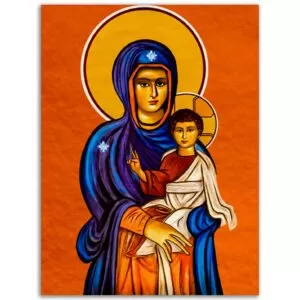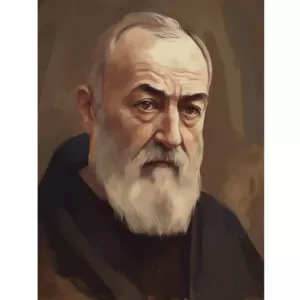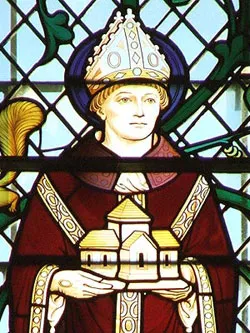SAINT JOSEPH

SAINT JOSEPH
Watchful Guardian of The Holy Family
Because you were the watchful guardian
of the Holy Family, please watch over
us, Christ’s chosen offspring. Like an
alert father kindly keep far from us
every taint of error or corruption.
From your place of glory on high come
to aid us in our conflict with the
powers of darkness.
V. St. Joseph, whom the infant Jesus
so much loved;
R. Grant us what we ask, please. (REQUEST)
Let us pray. Assist us, Lord, by the merits
of your foster father, St. Joseph, spouse of
your most Holy Mother. May his help gain for us what our own efforts
cannot. This we ask through you who live and reign with God the father
in union of the Holy Spirit, one God, for all ages. Amen.
Spouse of the
Blessed Virgin Mary and foster-father of Our Lord Jesus Christ.
The chief sources of information on the life of St. Joseph are
the first chapters of our first and third Gospels; they are practically also
the only reliable sources, for, whilst, on the holy patriarch’s life, as on
many other points connected with the Saviour’s history which are left
untouched by the canonical writings, the apocryphal literature is full of
details, the non-admittance of these works into the Canon of the Sacred Books
casts a strong suspicion upon their contents; and, even granted that some
of the facts recorded by them may be founded on trustworthy traditions, it is
in most instances next to impossible to discern and sift these particles of
true history from the fancies with which they are associated. Among these
apocryphal productions dealing more or less extensively with some episodes of
St. Joseph’s life may be noted the so-called “Gospel of James”, the
“Pseudo-Mathew”, the “Gospel of the Nativity of the Virgin Mary”, the Story of
Joseph the Carpenter”,
and the “Life of the Virgin and Death of Joseph”.
St. Mathew (1:16) calls St. Joseph
the son of Jacob; according to St. Luke (3:23), Heli was his father. This
is not the place to recite the many and most various endeavours to solve the
vexing questions arising from the divergences between both genealogies; nor
is it necessary to point out the explanation which meets best all the
requirements of the problem (see GENEALOGY OF CHRIST); suffice it to remind
the reader that, contrary to what was once advocated, most modern writers
readily admit that in both documents we possess the genealogy of Joseph, and
that it is quite possible to reconcile their data.
At any rate, Bethlehem,
the city of David and his descendants, appears to have been the birth-place
of Joseph. When, however, the Gospel history opens, namely, a few months
before the Annunciation, Joseph was settled at Nazareth. Why and when he
forsook his home-place to betake himself to Galilee is not ascertained; some
suppose — and the supposition is by no means improbable — that the then
moderate circumstances of the family and the necessity of earning a living may
have brought about the change. St. Joseph, indeed, was a tekton,
as we learn
from Matt, xiii, 55, and Mark, vi, 3. The word means both mechanic in general
and carpenter in particular; St. Justin vouches for the latter sense (Dial.
cum Tryph., lxxxviii, in P. G., VI, 688), and tradition has accepted this
interpretation, which is followed in the English Bible. It is probably at
Nazareth that Joseph betrothed and married her who was to become the Mother of
God. When the marriage took place, whether before or after the Incarnation,
is no easy matter to settle, and on this point the masters of exegesis have at
all times been at variance. Most modern commentators, following the footsteps
of St. Thomas, understand that, at the epoch of the Annunciation, the Blessed
Virgin was only affianced to Joseph; as St. Thomas notices, this
interpretation suits better all the evangelical data.
It will not be without interest to recall here, unreliable though they are,
the lengthy stories concerning St. Joseph’s marriage contained in the
apocryphal writings. When forty years of age, Joseph married a woman called
Melcha or Escha by some, Salome by others; they lived forty-nine years
together and had six children, two daughters and four sons, the youngest of
whom was James (the Less, “the Lord’s brother”). A year after his wife’s
death, as the priests announced through Judea that they wished to find in the
tribe of Judea a respectable man to espouse Mary, then twelve to fourteen
years of age, Joseph, who was at the time ninety years old, went up to
Jerusalem among the candidates; a miracle manifested the choice God had made
of Joseph, and two years later the Annunciation took place. These dreams, as
St. Jerome styles them, from which many a Christian artist has drawn his
inspiration (see, for instance, Raphael’s “Espousals of the Virgin”),
are void of authority; they nevertheless
acquired in the course of ages some popularity; in them some ecclesiastical
writers sought the answer to the well-known difficulty arising from the
mention in the Gospel of “the Lord’s brothers”; from them also popular
credulity has, contrary to all probability, as well as to the tradition
witnessed by old works of art, retained the belief that St. Joseph was an old
man at the time of marriage with the Mother of God. This marriage, true and
complete, was, in the intention of the spouses, to be virgin marriage (cf. St.
Aug., “De cons. Evang.”, II, i in P.L. XXXIV, 1071-72; “Cont. Julian.”, V, xii,
45 in P.L.. XLIV, 810; St. Thomas, III:28; III:29:2). But soon
was, the faith of Joseph in his spouse to be sorely tried: she was with child.
However painful the discovery must have been for him, unaware as he was of
the mystery of the Incarnation, his delicate feelings forbade him to defame
his affianced, and he thought on these things, behold the angel of the Lord
appeared to him in his sleep, saying: Joseph, son of David, fear not to take
unto thee Mary thy wife, for that which is conceived in her, is of the Holy
Ghost… And Joseph, rising from his sleep, did as the angel of he Lord had
commanded him, and took unto him his wife” (Matt., i, 19, 20, 24).
A few months later, the time came for Joseph and Mary to go to Bethlehem,
to be enrolled, according to the decree issued by Caesar Augustus: a new
source of anxiety for Joseph, for “her days were accomplished, that she
should be delivered”, and “there was no room for them in the inn (Luke, ii,
1-7). What must have been the thoughts of the holy man at the birth of the
Saviour, the coming of the shepherds and of the wise men, and at the events
which occurred at the time of the Presentation of Jesus in the Temple, we can
merely guess; St. Luke tells only that he was “wondering at those things which
were spoken concerning him” (ii, 33). New trials were soon to follow. The
news that a king of the Jews was born could not but kindle in the wicked heart
of the old and bloody tyrant, Herod, the fire of jealousy. Again “an angel of
the Lord appeared in sleep to Joseph, saying: Arise, and take the child and
his mother, and fly into Egypt: and be there until I shall tell thee” (Matt.,
ii, 13). The summons to go back to Palestine came only after a few years, and
the Holy Family settled again at Nazareth. St. Joseph’s was henceforth
the simple and uneventful life of an humble Jew, supporting himself and his
family by his work, and faithful to the religious practices commanded by the
Law or observed by pious Israelites. The only noteworthy incident recorded
by the Gospel is the loss of, and anxious quest for, Jesus, then twelve years
of old, when He had strayed during the yearly pilgrimage to the Holy City
(Luke, ii, 42-51). This is the last we hear of St. Joseph in the sacred
writings, and we may well suppose that Jesus’s foster-father died before the
beginning of Savior’s public life. In several circumstances, indeed, the
Gospels speak of the latter’s mother and brothers (Matt., xii, 46; Mark, iii,
31; Luke, viii, 19; John, vii, 3), but never do they speak of His father in
connection with the rest of the family; they tell us only that Our Lord, during
His public life was referred to as the son of Joseph ( John, i, 45; vi, 42;
Luke, iv, 22) the carpenter (Matt., xiii, 55). Would Jesus, moreover, when
about to die on the Cross, have entrusted His mother to John’s care, had St.
Joseph been still alive? According to the apocryphal “Story of Joseph the
Carpenter”, the holy man reached his hundred and eleventh year when he died,
on 20 July (A. D. 18 or 19). St. Epiphanius gives him ninety years of age
at the time of his demise; and if we are to believe the Venerable Bede, he was
buried in the Valley of Josaphat. In truth we do not know when St. Joseph
died; it is most unlikely that he attained the ripe old age spoken of by the
“Story of Joseph” and St. Epiphanius. The probability is that he died and was
buried at Nazareth.
Joseph was “a just man”. This praise bestowed by the Holy Ghost, and the
privilege of having been chosen by God to be the foster-father of Jesus and
the Spouse of the Virgin Mother, are the foundations of the honour paid to St.
Joseph by the Church. So well-grounded are these foundations that it is not a
little surprising that the cult of St. Joseph was so slow in winning
recognition. Foremost among the causes of this is the fact that “during the
first centuries of the Church’s existence, it was only the martyrs who enjoyed
veneration” (Kellner). Far from being ignored or passed over in silence
during the early Christian ages, St. Joseph’s perogatives were occasionally
descanted upon by the Fathers; even such eulogies as cannot be attributed to
the writers among whose works they found admittance bear witness that the
ideas and devotion therein expressed were familiar, not only to the
theologians and preachers, and must have been readily welcomed by the people.
The earliest traces of public recognition of the sanctity of St. Joseph are
to be found in the East. His feast, if we may trust the assertions of
Papebroch, was kept by the Copts as early as the beginning of the fourth
century. Nicephorus Callistus tells likewise — on what authority we do not
know — that in the great basilica erected at Bethlehem by St. Helena, there
was a gorgeous oratory dedicated to the honour of our saint. Certain it is,
at all events, that the feast of “Joseph the Carpenter” is entered, on 20
July, in one of the old Coptic Calendars in our possession, as also in a
Synazarium of the eighth and nineth century published by cardinal Mai (Script.
Vet. Nova Coll., IV, 15 sqq.). Greek menologies of a later date at least
mention St. Joseph on 25 or 26 December, and a twofold commemoration of him
along with other saints was made on the two Sundays next before and after
Christmas.
In the West the name of the foster-father of Our Lord (Nutritor Domini)
appears in local martyrologies of the nineth and tenth centuries, and we find
in 1129, for the first time, a church dedicated to his honour at Bologna. The
devotion, then merely provite, as it seems, gained a great impetus owing to
the influence and zeal of such saintly persons as St. Bernard, St. Thomas
Aquinas, St. Gertrude (d. 1310), and St. Bridget of Sweden (d. 1373).
According to Benedict XIV (De Serv. Dei beatif., I, iv, n. 11; xx, n. 17),
“the general opinion of the learned is that the Fathers of Carmel were the
first to import from the East into the West the laudable practice of giving
the fullest cultus to St. Joseph”. His feast, introduced towards the end
shortly afterwards, into the Dominican Calendar, gradually gained a foothold
in various dioceses of Western Europe. Among the most zealous promoters of
the devotion at epoch, St. Vincent Ferrer (d. 1419), Peter d’Ailly (d. 1420),
St. Bernadine of Sienna (d. 1444), and Jehan Charlier Gerson (d. 1429)
deserve an especial mention. Gerson, who had, in 1400, composed an Office of
the Espousals of Joseph particularly at the Council Constance (1414), in
promoting the public recognition of the cult of St. Joseph. Only under the
pontificate of Sixtus IV (1471-84), were the efforts of these holy men
rewarded by Roman Calendar (19 March). From that time the devotion acquired
greater and greater popularity, the dignity of the feast keeping pace with
this steady growth. At first only a festum simplex, it was soon elevated to a
double rite by Innocent VIII (1484-92), declared by Gregory XV, in 1621, a
festival of obligation, at the instance of the Emperors Ferdinand III and
Leopold I and of King Charles II of Spain, and raised to the rank of a double
of the second class by Clement XI (1700-21). Further, Benedict XIII, in
1726, inserted the name into the Litany of the Saints.
One festival in the year, however, was not deemed enough to satisfy the
piety of the people. The feast of the Espousals of the Blessed Virgin and St.
Joseph, so strenuously advocted by Gerson, and permitted first by Paul III to
the Franciscans, then to other religious orders and individual dioceses, was,
in 1725, granted to all countries that solicited it, a proper Office, compiled
by the Dominican Pierto Aurato, being assigned, and the day appointed being 23
January. Nor was this all, for the reformed Order of Carmelites, into which
St. Teresa had infused her great devotion to the foster-father of Jesus, chose
him, in 1621, for their patron, and in 1689, were allowed to celebrate the
feast of his Patronage on the third Sunday after Easter. This feast, soon,
adopted throughout the Spanish Kingdom, was later on extended to all states
and dioceses which asked for the privilege. No devotion, perhaps, has grown
so universal, none seems to have appealed so forcibly to the heart of the
Christian people, and particularly of the labouring classes, during the
nineteenth century, as that of St. Joseph.
This wonderful and unprecedented increase of popularity called for a new
lustre to be added to the cult of the saint. Accordingly, one of the first
acts of the pontificate of Pius IX, himself singularly devoted to St. Joseph,
was to extend to the whole Church the feast of the Patronage (1847), and in
December, 1870, according to the wishes of the bishops and of all the
faithful, he solemnly declared the Holy Patriarch Joseph, patron of the
Catholic Church, and enjoined that his feast (19 March) should henceforth be
celebrated as a double of the first class (but without octave, on account of
Lent). Following the footsteps of their predecessor, Leo XIII and Pius X have
shown an equal desire to add their own jewel to the crown of St. Joseph: the
former, by permitting on certain days the reading of the votive Office of the
saint; and the latter by approving, on 18 March, 1909, a litany in honour of
him whose name he had received in baptism.
rosary.team
















